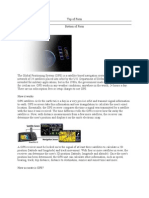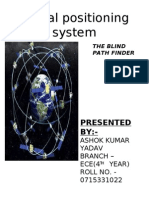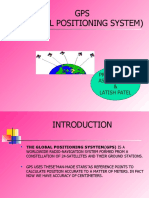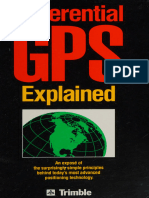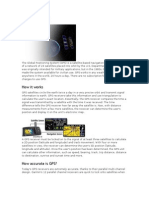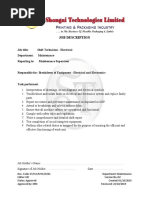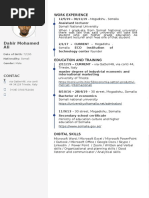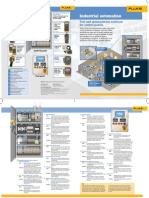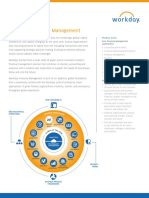GPSGuideforBeginners Manual
GPSGuideforBeginners Manual
Uploaded by
Sergio MarinCopyright:
Available Formats
GPSGuideforBeginners Manual
GPSGuideforBeginners Manual
Uploaded by
Sergio MarinOriginal Title
Copyright
Available Formats
Share this document
Did you find this document useful?
Is this content inappropriate?
Copyright:
Available Formats
GPSGuideforBeginners Manual
GPSGuideforBeginners Manual
Uploaded by
Sergio MarinCopyright:
Available Formats
GPS GUIDE
for beginners
© 2000 GARMIN Corporation
GARMIN International, Inc.
1200 East 151st Street, Olathe, Kansas 66062, U.S.A.
GARMIN (Europe) Ltd.
Unit 5, The Quadrangle, Abbey Park Industrial Estate, Romsey, SO51 9AQ, U.K.
GARMIN Corporation
No. 68, Jangshu 2nd Rd., Shijr, Taipei County, Taiwan
www.garmin.com
Part Number 190-00224-00 Rev. A
© 2000 GARMIN Corporation
GARMIN International, Inc.
1200 East 151st Street, Olathe, Kansas 66062, U.S.A.
Tel. 913/397.8200 or 800/800.1020
Fax 913/397.8282
GARMIN (Europe) Ltd.
Unit 5, The Quadrangle, Abbey Park Industrial Estate, Romsey, SO51 9AQ, U.K.
Tel. 44/1794.519944
Fax 44/1794.519222
GARMIN Corporation
No. 68, Jangshu 2nd Rd., Shijr, Taipei County, Taiwan
Tel. 886/2.2642.9199
Fax 886/2.2642.9099
All rights reserved. Except as expressly provided herein, no part of this guide may be
reproduced, copied, transmitted, disseminated, downloaded or stored in any storage
medium, for any purpose without prior written consent of GARMIN Corporation.
GARMIN Corporation hereby grants permission to download a single copy of this
guide onto a hard drive or other electronic storage medium to be viewed for
personal use, provided that such electronic or printed copy of this guide contains
the complete text of this copyright notice and provided further that any unauthor-
ized commercial distribution of this guide is strictly prohibited.
Web site address: www.garmin.com
GARMIN, G-Chart and TracBack are registered trademarks and MapSource is a
trademark of GARMIN Corporation and may not be used without the express
permission of GARMIN Corporation.
December 2000 Part Number 190-00224-00 Rev. A Printed in U.S.A
Introduction
Have you ever been lost and wished there was an easy way to find out
which way you needed to go? Ever find that perfect fishing or hunting spot
and not been able to remember how to get back to it easily? How about
finding yourself out hiking and not known which direction you should
go to get back to your camp or car? Ever been flying along and needed
to locate the nearest airport or identify the type of airspace you were in?
Maybe you’ve been faced with the fact that it’s time to pull over and ask
someone for directions?
With a GARMIN GPS unit you could know where you were located on
the planet at all times. From the time our first GPS handhelds supported
the Coalition forces in the Gulf War to our current reputation as the first
name in GPS innovation, GARMIN has helped to take GPS to new heights
by going beyond the ordinary features and performance found in typical
GPS receivers.
GPS technology is rapidly changing how people find their way around
the Earth. Whether it be for fun, saving lives, getting there faster, or what-
ever use you can dream up, GPS navigation is becoming more common
every day. We hope that this guide will give you enough information to get
you involved in the fun that awaits you.
What is GPS?
GPS acronym noun
Global Positioning System. A network of satellites that
continuously transmit coded information, which makes
it possible to precisely identify locations on earth
by measuring distance from the satellites .
As stated in the definition above,
GPS stands for Global Positioning
System, and refers to a group of U.S.
Department of Defense satellites con-
stantly circling the earth. The satellites
transmit very low power radio signals
allowing anyone with a GPS receiver to
determine their location on Earth.
This remarkable system was not cheap to
build, costing the U.S. billions of dollars. Ongoing
maintenance, including the launch of replacement satellites,
adds to the cost of the system. Amazingly, GPS actually predates the
1
GPS For Beginners.indd 1 01/12/01, 10:27 AM
introduction of the personal computer. Its designers may not have foreseen a
day when we would be carrying small portable receivers, weighing less than
a pound, that would not only tell us where we are in position coordinates
(latitude/longitude), but would even display our location on an electronic
map along with cities, streets and more.
These designers originally had a military application in mind. GPS
receivers would aid navigation, troop deployment and artillery fire (among
other applications). Fortunately, an executive decree in the 1980s made GPS
available for civilian use also. Now everyone gets to enjoy the benefits of
GPS! The capability is almost unlimited. Sometimes people ask if they can
use the system for free-YES! (Well, it was your tax money that paid for
it.) So just break out that GPS receiver, put the batteries in and dive right
into the fun!
Who uses GPS?
GPS has a variety of applications on land, at sea and in the air. Basically,
GPS allows you to record or create locations from places on the earth and
help you navigate to and from those spots. GPS can be used everywhere
except where it’s impossible to receive the signal such as inside buildings;
in caves, parking garages, and other subterranean locations; and underwater.
The most common airborne applications include navigation by general avia-
tion and commercial aircraft. At sea, GPS is typically used for navigation by
recreational boaters and fishing enthusiasts.
Land-based applications are more diverse. The scientific community
uses GPS for its precision timing capability and a myriad of other applica-
tions. Surveyors use GPS for an increasing portion of their work. GPS offers
an incredible cost savings by drastically reducing setup time at the survey
site. It also provides amazing accuracy. Basic survey units can offer accura-
cies down to one meter. More expensive systems can provide accuracies
2
GPS For Beginners.indd 2 01/12/01, 10:27 AM
to within a centimeter! Recreational uses of GPS are almost as varied as
the number of recreational sports available. GPS is becoming increasingly
popular among hikers, hunters, snowmobilers, mountain bikers, and cross-
country skiers, just to name a few. If you are involved in an activity or sport
where you need to keep track of where you are, find your way to a specified
location, or know what direction and how fast you’re going, you can benefit
from the Global Positioning System.
GPS is rapidly becoming commonplace in automobiles as well. Some
basic systems are already in place, providing emergency roadside assistance
at the push of a button (by transmitting your current position to a dispatch
center). More sophisticated systems can show the vehicle’s position on an
electronic map display, allowing drivers to keep track of where they are
and look up street addresses, restaurants, hotels and other destinations.
Some systems can even automatically create a route and give turn-by-turn
directions to a designated location.
You don’t have to be a rocket scientist to learn how GPS works. All you
need is a little background knowledge plus the desire to explore
and understand the world of GPS. Don’t let terms like “pseudo-
random”, “anti-spoofing” and “P Code” frighten you. Let’s dig
right in and start to become familiar with the best navigation tool
to come along since the invention of the compass.
The 3 Segments of GPS
The NAVSTAR system (the acronym for Navigation Satellite Timing
and Ranging, the official U.S. Department of Defense name for GPS)
consists of a space segment (the satellites), a control segment (the ground
stations), and a user segment (you and your GPS receiver).
Now let’s take the three parts of the system and discuss them in more
detail. Then we’ll look more closely at how GPS works.
GPS For Beginners.indd 3 01/12/01, 10:27 AM
SPACE SEGMENT
CONTROL SEGMENT USER SEGMENT
• The Space Segment
The space segment, which consists of at least 24 satellites (21 active
plus 3 operating spares) is the heart of the system. The satellites are in
what’s called a “high orbit” about 12,000 miles above the Earth’s surface.
Operating at such a high altitude allows the signals to cover a greater area.
The satellites are arranged in their orbits so a GPS receiver on earth can
always receive from at least four of them at any given time.
The satellites are travelling at speeds of 7,000 miles an hour, which
allows them to circle the earth once every 12 hours. They are powered by
solar energy and are built to last about 10 years. If the solar energy fails
(eclipses, etc.), they have backup batteries on board to keep them running.
They also have small rocket boosters to keep them flying in the correct
path.
The first GPS satellites were launched into space in 1978. A full constel-
lation of 24 satellites was achieved in 1994, completing the system. Money
is in the U.S. Department of Defense budget to continue buying new satel-
lites, sending them up to keep the system running for years to come.
Each satellite transmits low power radio signals on several frequencies
(designated L1, L2, etc.). Civilian GPS receivers “listen” on the L1 frequency
of 1575.42 MHz in the UHF band. The signal travels “line of sight”, meaning
it will pass through clouds, glass and plastic, but will not go through most
solid objects such as buildings and mountains.
GPS For Beginners.indd 4 01/12/01, 10:27 AM
To give you some idea of where the L1 signal is on the radio dial, your
favorite FM radio station broadcasts on a frequency somewhere between 88
and 108 MHz (and sounds much better!). The satellite signals are also very
low power signals, on the order of 20-50 watts. Your local FM radio station
is around 100,000 watts. Imagine trying to listen to a 50-watt radio station
transmitting from 12,000 miles away! That’s why it’s important to have a
clear view of the sky when using your GPS.
L1 contains two “pseudorandom” (a complex pattern of digital code)
signals, the Protected (P) code and the Coarse/Acquisition (C/A) code. Each
satellite transmits a unique code, allowing the GPS receiver to identify the
signals. “Anti-spoofing” refers to the scrambling of the P code in order to
prevent its unauthorized access. The P code is also called the “P (Y)” or
“Y” code.
The main purpose of these coded signals is to allow for calculating the
travel time from the satellite to the GPS receiver on the Earth. This travel
time is also called the Time of Arrival. The travel time multiplied by
the speed of light equals the satellite range (distance from the satellite to
the GPS receiver). The Navigation Message (the information the satellites
transmit to a receiver) contains the satellite orbital and clock information
and general system status messages and an ionospheric delay model. The
satellite signals are timed using highly accurate atomic clocks.
• The Control Segment
The “control” segment does what its name implies — it “controls” the
GPS satellites by tracking them and then providing them with corrected
orbital and clock (time) information. There are five control stations located
around the world — four unmanned monitoring stations and one “master
control station”. The four unmanned receiving stations constantly receive
data from the satellites and then send that information to the master control
station. The master control station “corrects” the satellite data
and, together with two other antenna sites, sends (“uplinks”)
the information to the GPS satellites.
• The User Segment
The user segment simply consists of you and your GPS
receiver. As mentioned previously, the user segment consists of boaters,
pilots, hikers, hunters, the military and anyone else who wants to know
where they are, where they have been or where they are going.
GPS For Beginners.indd 5 01/12/01, 10:27 AM
?
GPS-How Does it Work?
• Location is Everything ?
Now for the fun part of how it works.
The GPS receiver has to know two things if it’s ?
going to do its job. It has to know WHERE the
satellites are (location) and how FAR AWAY ?
they are (distance).
Let’s first look at how the GPS receiver knows where the satellites are
located in space. The GPS receiver picks up two kinds of coded information
from the satellites. One type of information, called “almanac” data, contains
the approximate positions (locations) of the satellites. This data is continu-
ously transmitted and stored in the memory of the GPS receiver so it knows
the orbits of the satellites and where each satellite is supposed to be. The
almanac data is periodically updated with new information as the satellites
move around.
Any satellite can travel slightly out of orbit, so the ground monitor
stations keep track of the satellite orbits, altitude, location, and speed. The
ground stations send the orbital data to the master control station, which in
turn sends corrected data up to the satellites. This corrected and exact posi-
tion data is called the “ephemeris” (pronounced: i-’fe-me-res) data, which is
valid for about four to six hours, and is transmitted in the coded information
to the GPS receiver.
So, having received the almanac and ephemeris data, the GPS receiver
knows the position (location) of the satellites at all times.
• Time is of the Essence
Even though the GPS receiver knows the precise location of the satellites
in space, it still needs to know how far away the satellites are (the distance)
so it can determine its position on Earth. There is a simple formula that tells
the receiver how far it is from each satellite:
Your distance from a given satellite object equals the veloc-
ity of the transmitted signal multiplied by the time it takes the
signal to reach you (Velocity x Travel Time = Distance).
Remember as a kid how you could find out how far
a thunderstorm was from you? When you saw a lightning
flash you counted the number of seconds until you heard the
thunder. The longer the count, the further away the storm was.
GPS works on the same principle, called “Time of Arrival”.
6
GPS For Beginners.indd 6 01/12/01, 10:27 AM
Using the same basic formula to determine distance, the receiver
already knows the velocity. It’s the speed of a radio wave — 186,000 miles
per second (the speed of light), less any delay as the signal travels through
the Earth’s atmosphere.
Now the GPS receiver needs to determine the time part of the formula.
The answer lies in the coded signals the satellites transmit. The transmitted
code is called “pseudo-random code” because it looks like a noise signal.
When a satellite is generating the pseudo-random code, the GPS receiver is
generating the same code and tries to match it up to the satellite’s code. The
receiver then compares the two codes to determine how much it needs to
delay (or shift) its code to match the satellite code. This delay time (shift) is
multiplied by the speed of light to get the distance.
Your GPS receiver clock does not keep the time as precisely as the
satellite clocks. Putting an atomic clock in your GPS receiver would make
it much larger and far too expensive! So each distance measurement needs
to be corrected to account for the GPS receiver’s internal clock error. For
this reason, the range measurement is referred to as a “pseudo-range”. To
determine position using pseudo-range data, a minimum of four satellites
must be tracked and the four fixes must be recomputed until the clock
error disappears.
• Coming Full Circle
Now that we have both satellite location and distance, the receiver can
determine a position. Let’s say we are 11,000 miles from one satellite. Our
location would be somewhere on an imaginary sphere that has the satellite
in the center with a radius of 11,000 miles. Then let’s say we are 12,000
miles from another satellite. The second sphere would intersect the
first sphere to create a common circle. If we add a third satellite,
at a distance of 13,000 miles, we now have two common points
Position somewhere on
where the three spheres intersect.
edge of common circle.
Even though there are two
possible positions, they differ
greatly in latitude/longitude posi-
tion AND altitude. To determine
which of the two common points
is your actual position, you’ll need 1 2
to enter your approximate alti-
tude into the GPS receiver. This
will allow the receiver to calculate
7
GPS For Beginners.indd 7 01/12/01, 10:27 AM
Position at one of two
possible points.
a two-dimensional position (latitude,
longitude). However, by adding a
fourth satellite, the receiver can deter-
mine your three-dimensional position
(latitude, longitude, altitude). Let’s say
our distance from a fourth satellite
is 10,000 miles. We now have a
fourth sphere intersecting the first
three spheres at one common point.
Almanac Data
The unit stores data about where the satellites are located at any given
time. This data is called the almanac. Sometimes when the GPS unit is not
turned on for a length of time, the almanac can get outdated or “cold”.
When the GPS receiver is “cold”, it could take
longer to acquire satellites. A receiver is considered
“warm” when the data has been collected from the
satellites within the last four to six hours. When you’re
looking for a GPS unit to buy, you may see “cold”
and “warm” acquisition time specifications. If the time
it takes the GPS unit to lock on to the signals and calculate a position is
important to you, be sure to check the acquisition times.
Once the GPS has locked onto enough satellites to calculate a position,
you are ready to begin navigating! Most units will display a position page
or a page showing your position on a map (map screen) that will assist you
in your navigation.
GPS Receiver Technology
Most modern GPS receivers are a parallel multi-channel design. Older
single-channel designs were once popular, but were limited in their ability to
continuously receive signals in the toughest environments — such as under
heavy tree cover. Parallel receivers typically have from between five and 12
receiver circuits, each devoted to one particular satellite signal, so strong
locks can be maintained on all the satellites at all times. Parallel-channel
receivers are quick to lock onto satellites when first turned on and they
are unequaled in their ability to receive the satellite signals even in difficult
conditions such as dense foliage or urban settings with tall buildings.
GPS For Beginners.indd 8 01/12/01, 10:27 AM
Sources of Errors
Civilian GPS receivers have potential position errors due to the result of
the accumulated errors due primarily to some of the following sources:
• Ionosphere and troposphere delays — The satellite signal slows as
it passes through the atmosphere. The system uses a built-in “model”
that calculates an average, but not an exact, amount of delay.
• Signal multi-path — Occurs when the GPS signal is reflected off
objects such as tall buildings or large rock surfaces before it reaches
the receiver. This increases the travel time of the signal, thereby causing
errors.
• Receiver clock errors — Since it is not practical to have an atomic
clock in your GPS receiver, the built-in clock can have very slight
timing errors.
• Orbital errors — Also known as “ephemeris errors”, these are inac-
curacies of the satellite’s reported location.
• Number of satellites visible — The more satellites the receiver can
“see”, the better the accuracy. Buildings, terrain, electronic interference,
or sometimes even dense foliage can block signal reception, causing
position errors or possibly no position reading at all. The clearer
the view, the better the reception. GPS units will not work indoors
(typically), underwater, or underground.
Multipath Error
Blocked Signal
GPS For Beginners.indd 9 01/12/01, 10:27 AM
• Satellite geometry/shading — This refers to the relative position of
the satellites at any given time. Ideal satellite geometry exists when
the satellites are located at wide angles relative to each other. Poor
geometry results when the satellites are located in a line or in a tight
grouping.
• Intentional degradation of the satellite signal — The U.S. mili-
tary’s intentional degradation of the signal is known as “Selective Avail-
ability” (SA) and is intended to prevent military adversaries from using
the highly accurate GPS signals. SA accounts for the majority of the
error in the range. SA was turned off May 2, 2000, and is currently not
active. This means you can expect typical GPS accuracies in the range
of 6-12 meters (about 20-40 feet).
However, accuracy can be improved by combining the GPS receiver
with a Differential GPS (or DGPS) receiver, which can operate from
several possible sources to help reduce some of the sources of errors
described above. The next section explains DGPS and how it works.
DGPS-How Does it Work?
Differential GPS works by placing a GPS receiver (called a
reference station) at a known location. Since the reference station knows its
exact location, it can determine the errors in the satellite signals. It does
this by measuring the ranges to each satellite using the signals received and
comparing these measured ranges to the actual ranges calculated from its
known position. The difference between the measured and calculated range
AL
GN
SI
S
GP
GPS
SIG
NAL
DGPS
C
O (CORR
R ECTIO
DA C
R
E N) SIG
GPS RECEIVER TA TI NAL
STATION AND O
N
DGPS TRANSMITTER
SHIPBOARD GPS AND
DGPS RECEIVERS
10
GPS For Beginners.indd 10 01/12/01, 10:27 AM
for each satellite in view becomes a “differential correction”. The differential
corrections for each tracked satellite are formatted into a correction message
and transmitted to DGPS receivers. These differential corrections are then
applied to the GPS receiver’s calculations, removing many of the common
errors and improving accuracy. The level of accuracy obtained is a function
of the GPS receiver and the similarity of its “environment” to that of
the reference station, especially its proximity to the station. The reference
station receiver determines the error components and provides corrections
to the GPS receiver in real time. Corrections can be transmitted over FM
radio frequencies, by satellite, or by beacon transmitters maintained by the
U.S. Coast Guard. Typical DGPS accuracy is 1-5 meters (about 3-16 feet).
WAAS
When we fly, there is one thing we all desire: SAFETY (and more
legroom!) Exceptional positioning information is the key to flight safety. In
deteriorating weather conditions, when visual navigation is difficult or not
possible, we need the best position accuracy possible. Enter the “Wide Area
Augmentation System” (now that’s a mouthful!) or simply WAAS*. “Wide
Area” refers to a network of 25 ground reference stations that cover the
entire U.S. and some of Canada and Mexico. Implemented by the FAA
(Federal Aviation Administration) for aviation users, these 25 reference
stations are located at precisely surveyed spots and compare GPS distance
measurements to known values. Each reference station is linked to a master
station, which puts together a correction message and broadcasts it via
satellite. WAAS capable receivers typically have accuracies of 3-5 meters
horizontally and 3-7 meters in altitude.
* WAAS is not operational at the time of this writing.
11
GPS For Beginners.indd 11 01/12/01, 10:27 AM
Mapping: Where Am I?
Have you ever looked at a map and wished you could pinpoint your
exact location? Are you or is someone you know “directionally challenged”?
Ever find a great hunting or fishing spot and want to get back to it easily?
A GPS unit may be just what you need to know where you are and where
you are going. GARMIN units are available with different types of map data.
Models vary from having no map, to a basemap, to a highly detailed map.
• Nonmapping Units
GPS units with no map detail have a plotter screen that can show an
overhead view of your location relative to any waypoints, routes, or track
logs (see definitions in Navigation section) you have created. The plotter
screen will aid in determining your position in relation to these items. Most
GARMIN GPS receivers will have the ability to show this basic information.
Some models have an additional city point database that displays city
locations.
• Basemap Units
A GARMIN unit with a basemap will typically show interstates, U.S. and
state highways, major thoroughfares in metro areas, lakes, rivers, railroads,
coastlines, cities, airport locations, and exit information for the federal
interstate highway system.
12
GPS For Beginners.indd 12 01/12/01, 10:27 AM
• Mapping Units
By stepping up to a unit with the ability to download detailed map
data from CD-ROMs, on-screen information really takes a leap forward.
Map data may include business and residential streets, restaurants, banks,
gas stations, tourist attractions, marine navigational data, boat ramps, topo-
graphic detail, off-road trails and much, much more. Imagine being able to
look up and navigate to any street address contained in a huge database
using an electronic map that shows street-level detail! Map data can be
incorporated into the unit either by using a data cartridge or by download-
ing the information directly from a CD to the GPS unit. Some units
utilize GARMIN’s pre-programmed G-chart™ cartridges for specific areas
or regions. Others use a blank cartridge, combined with a PC and a
MapSource™ CD, allowing you to select an area of detail to program into
the data cartridge. Yet other units can have the data loaded directly into
internal memory without the need for data cartridges.
Navigation: Where Am I Going?
• Waypoints
The main purpose of navigation is to be able to get from point A to
point B as easily as possible. GARMIN units can store several hundred
points, or locations, called “waypoints”. Your house, dock, airport, parked
car, a great fishing/hunting spot or even some scenic spots you would like
to revisit are just a few examples of the locations you could store and
navigate back to later. Well, what if you have never been to the spot, but
know its coordinates or where it is on a map? With GARMIN receivers, you
can even create waypoints of places you have never been to and navigate
your way (or GOTO) to that spot.
• GOTO
The GOTO feature is as simple as selecting a destination
point and telling your GPS to “go to it.” The unit will draw a
straight line to that point and guide you there with a pointer
arrow, compass bearing (the direction to the point), desired
course line, or a 3D “highway” representation. When you are
navigating to a specific place, the GPS always keeps track of
13
GPS For Beginners.indd 13 01/12/01, 10:27 AM
where you are, where you are going, how fast you are going, how far away
you are from your destination, and how long it will take you to get there!
But what if there is a mountain, island or canyon between you and your
destination and you can’t navigate in a straight line to your spot? You
can tell the unit to go to a series of waypoints in a certain order called
a “route”.
• Routes
Remember the connect-the-dots pictures? You drew a line from the #1
dot to #2, to #3 and so on. Imagine that the waypoints you want to go to
are the dots and the route is the line connecting the dots. Since you get to
put your own numbers on the dots, you are basically saying, “I want to go
from here, to here, to here, and so on, in this order!” It may not make a
4
2
1
pretty picture when you look at it, but it will definitely get you where you
need to go! With all GARMIN units, you can also see where you have been,
displayed in the form of a “track log”.
• Track Logs
As you travel along, your GPS unit will automatically record your
journey in a “track log”. Think of a track log as a bread crumb trail
of where you have been. As you twist and turn along a forest path or
through a group of islands, your every movement is being stored in the
GPS. If you want to travel back along the same path you came, you can
simply activate GARMIN’s TracBack® feature. When activated, the unit
will look at your track log and automatically create a reverse route along
your same path, taking you back to where you started. You can even store
this information to use over and over again, so you’ll know that you are
heading in the right direction!
14
GPS For Beginners.indd 14 01/12/01, 10:27 AM
• True and Magnetic North
With direction in mind, you’ll need to determine if you want to N
use true north or magnetic north references. True north uses the
North Pole as a 0° reference, whereas magnetic north uses the
Magnetic North Pole, which is actually in northern Canada. If W E
you are using your GPS along with a standard compass, you
will normally set the GPS to magnetic north. The difference between
S
true and magnetic north at your current location is known as “magnetic
variation” (or magnetic declination). GARMIN receivers have a built-in
model of the earth’s magnetic variation and can automatically set the varia-
tion for your location anywhere on the planet. You may also choose to set
the variation manually using a user-defined north setting.
• Position Formats and Grids
Your current location can be viewed in the GPS in the form of coor-
dinates. Since different maps and charts use different position
formats, GARMIN GPS
units allow you to choose
the correct coordinate
system for your particular
use. The most common
format is latitude and lon-
gitude, which is utilized
by all GARMIN units.
On most models, you
may choose to change
the position format to use
other coordinate systems.
UTM/UPS (Universal Transverse Mercator/Universal Polar Stereographic)
are easy-to-use metric grids that are found on most USGS topographic
quadrangle maps. MGRS (Military Grid Reference System) is very similar
to UTM/UPS and is used mainly with military maps. Several other grids,
including a user-definable grid (for the advanced user), may also be
selected on most units.
• Map Datums
Maps and charts are essentially grids created from a starting reference
point called a datum. Many maps still being used today were originally
created decades ago. Over time, technology has allowed us to improve our
surveying skills and create more accurate maps. However, there is still a
15
GPS For Beginners.indd 15 01/12/01, 10:27 AM
need to adapt GPS receivers to use with those older maps. Most GARMIN
GPS receivers include over 100 available map datums, which allow you to
switch to a setting that matches your map. Using a map datum that does
not match the chart you are using can result in significant differences in
position information. Most good navigational charts and maps will have
the datum listed, normally somewhere in the smaller, side print or in the
legend. The most common US map datums are World Geodetic System
1984 (WGS 84), North American Datum 1983 (NAD 83), and North
American Datum 1927 (NAD 27). When looking through a unit’s list of
datums, be sure to remember that they are all mathematical models of
the Earth’s shape used to determine a position, not actual maps built into
the unit.
Map Datums On
USGS Topo Map
• Complementary Navigation Aids
Even with GPS technology becoming better every day, it is still a good
idea to have backup navigation. Having a paper map, a simple compass,
and knowledge of manual navigation is a good, safe practice of prudent
navigators! Remember, GPS is a complement to navigation and should not
be the only navigational tool you use.
16
GPS For Beginners.indd 16 01/12/01, 10:27 AM
Purchasing Decisions
Trying to decide which GPS unit and accessories to get could be
overwhelming, especially with the number of choices on the market today.
Think about what you mainly want to use the unit for: boating, flying,
driving, hunting, fishing, biking, hiking, etc. Since all GARMIN GPS units
can show your position and basic navigation information, an inexpensive
entry-level unit can be a great way to enter the world of GPS navigation.
All GARMIN units also have a backlight feature which will allow you to use
your GPS both day and night. Choosing a unit with more features, such as
mapping detail, can provide an entirely new level of position awareness and
navigation capability, while still being easy to operate. GARMIN’s intuitive,
menu-driven operation makes learning how to use the GPS receiver simple.
In designing our GPS products, we utilize customer feedback to develop
better, more user-friendly products.
Consider these issues when selecting a GPS unit:
Battery Life — If you are going to be using the unit away from
an auxiliary power source, consider the weight of carrying extra batteries.
Units with color displays tend to have a decreased battery life compared to
grayscale displays, requiring more frequent battery changes.
Size and Weight — GARMIN units are available in an array of differ-
ent sizes and shapes: small lightweight handhelds, large display chartplot-
ters, and panel mounted aviation models.
Antenna Configuration — Are you going to be using the unit mainly
in the open? How about in a car? Whether you need a unit with a built-in
antenna and the capacity to attach an external antenna, a fixed-mount unit
with a mountable external antenna, or an aviation antenna, GARMIN has
the products to keep you tracking satellites.
DGPS Capability — Do you need the best accuracy possible? If so,
combining a Differential GPS (DGPS) receiver with your GPS unit will give
you the best accuracy possible. Most GARMIN GPS units are DGPS-ready
and some fixed-mount marine units even have the DGPS receiver built in.
Price — What type of unit fits your price range? Keep in mind that
ALL GARMIN GPS units will still allow you to mark waypoints and help
you navigate to that spot. The rest is up to you to decide which features
appeal to your needs. (And, of course, the features you just enjoy having!)
All the way from the most basic GPS to a high-end mapping unit, GARMIN
has a GPS receiver to fit just about every need!
17
GPS For Beginners.indd 17 01/12/01, 10:27 AM
Selecting Accessories
All GARMIN units come with the basics of what you need to get
started. You can fill your accessory needs through any local GARMIN
dealer or check out and purchase your unit’s available accessories on the
GARMIN Web site: www.garmin.com. Some accessories to consider are:
Remote Antenna — will a built-in antenna’s view be shaded, such as
in a boat cabin, in the cockpit of an airplane or under the roof of a car? An
external antenna will allow you to use your GPS in an area where a clear
view of the sky may not always be possible.
External Power Source — Even with the long battery life you get
on most GARMIN products, it’s always nice to save on batteries by using a
cigarette lighter adapter or AC power source!
Mounts — When you need your hands free, a mount for your GPS
can be useful. Many units come with a mount, and several additional
mounts are available for other products in our line.
Software — Whether your need is to save your favorite waypoints
or plan a trip, GARMIN’s MapSource software can fit the bill! MapSource
software allows you to view color maps on a personal computer, with
zoom and pan functions for easy map browsing. Use the trip and waypoint
management functions to create waypoints, routes, and tracks and transfer
them between your PC and nearly all GARMIN GPS units. This is excellent
for planning your next outdoor adventure, business trip, vacation, or
recreational outing without ever leaving your house.
For those units that accept the map transfer feature, users can also
select individual maps in areas of interest and download the selected
maps to a compatible GARMIN GPS (See individual unit specifications
for compatibility.) Simply connect your GARMIN GPS to your PC using
a PC interface cable. Select the map areas on screen, and with a click of
the mouse, the information downloads to your GPS. Some units require a
blank 8,16, 32, 64 or 128 MB data card to download.
All MapSource products include the trip and waypoint management
functions for transferring waypoints, routes and tracks. Your preference for
map detail and your specific activities will determine which MapSource CD
is right for you. MapSource gives you the flexibility to select the mapping
coverage you need.
18
GPS For Beginners.indd 18 01/12/01, 10:27 AM
G-Charts — If you would like to add more marine navigation data to
your GARMIN chartplotter, GARMIN offers two different types of marine
cartography data cards: inland and offshore. GARMIN’s G-charts also come
in two sizes: standard or micro. Offshore G-charts feature
complete depth contours, navaids, and port plans that show
names of harbors, towns, marinas, inlets, hazards, and other
data. Inland G-charts have detailed inland cartography as
well as interstates, highways, county roads, boat ramps, and
services.
Web site Features
Need to find out more information on GARMIN products or GPS
technology? Stop by www.garmin.com to find a full-service Web site to
help you with your GPS needs. You will find specifications on our entire
line of products, a dealer locator to help you find where to buy GARMIN
products in your area, GARMIN’s online store where you may purchase
accessories directly, online product registration and product testimonials.
Services such as FAQs (Frequently Asked Questions), free downloads of
manuals and unit operating software, links to learn more about GPS, and
even job opportunities at GARMIN are just a click away! Stop by our
cartography section to preview MapSource map detail or browse through
our listing of available offshore and inland G-charts and much more.
19
GPS For Beginners.indd 19 01/12/01, 10:27 AM
Our Customer Commitment
GARMIN International aims to enrich the lives of
customers, suppliers, distributors, and employees by pro-
viding the very best products that offer superior quality,
safety, and operational features at affordable prices. While
our immediate success has resulted from developing inno-
vative products for a variety of markets, our long-term
success is based on our commitment to support our cus-
tomers after the sale. We are winning over new customers
with quality products, tremendous value, superior service,
and we are working hard to create more loyal GARMIN
supporters for many years to come.
20
GPS For Beginners.indd 20 01/12/01, 10:27 AM
GPS GUIDE
for beginners
© 2000 GARMIN Corporation
GARMIN International, Inc.
1200 East 151st Street, Olathe, Kansas 66062, U.S.A.
GARMIN (Europe) Ltd.
Unit 5, The Quadrangle, Abbey Park Industrial Estate, Romsey, SO51 9AQ, U.K.
GARMIN Corporation
No. 68, Jangshu 2nd Rd., Shijr, Taipei County, Taiwan
www.garmin.com
Part Number 190-00224-00 Rev. A
You might also like
- Universiti Malaysia Sarawak: Faculty of EngineeringDocument11 pagesUniversiti Malaysia Sarawak: Faculty of EngineeringMohd Nik Harith FawwazNo ratings yet
- Bayesian Learning Unit 3 PDFDocument18 pagesBayesian Learning Unit 3 PDFHarryNo ratings yet
- SEER 1000 OperatingDocument124 pagesSEER 1000 OperatingNoah Asideka100% (4)
- GPS Guide For BeginnersDocument23 pagesGPS Guide For Beginnersalbatros_60100% (1)
- GPS GUIDE For BeginnersDocument9 pagesGPS GUIDE For BeginnersrajaNo ratings yet
- What Is GPS?: How It WorksDocument3 pagesWhat Is GPS?: How It WorksNikhil AgrawalNo ratings yet
- Gps SystemDocument21 pagesGps SystemRaishNo ratings yet
- What Is GPS?: Top of Form Bottom of FormDocument19 pagesWhat Is GPS?: Top of Form Bottom of FormSubbireddy BhumireddyNo ratings yet
- Positioning: GlobalDocument14 pagesPositioning: GlobalAbdul QuddusNo ratings yet
- Global Positioning System (GPS) : Rolly Dc. MulatoDocument45 pagesGlobal Positioning System (GPS) : Rolly Dc. MulatoRhea BinayaNo ratings yet
- Global Positioning System: Presented BYDocument16 pagesGlobal Positioning System: Presented BYAshok YadavNo ratings yet
- What Is GPSDocument7 pagesWhat Is GPSJay MehtaNo ratings yet
- GPS Navigation Project Group-4 RedoneDocument16 pagesGPS Navigation Project Group-4 RedoneShubham AgrawalNo ratings yet
- How GPS WorksDocument8 pagesHow GPS Workssomaya bakrNo ratings yet
- Garmin - What Is GPSDocument3 pagesGarmin - What Is GPSabebotalardyNo ratings yet
- Global Positining System: Working, Errors and Correction Using DgpsDocument18 pagesGlobal Positining System: Working, Errors and Correction Using Dgpsbalu54No ratings yet
- Advanced Engineering Survey Lab ManualDocument29 pagesAdvanced Engineering Survey Lab ManualShabbir AhmadNo ratings yet
- GPS (Global Positioning System) : Prepared By: Ashish Gupta & Latish PatelDocument19 pagesGPS (Global Positioning System) : Prepared By: Ashish Gupta & Latish PatelSunil PillaiNo ratings yet
- What Is GPS and How Is It Used in Land Surveying?Document5 pagesWhat Is GPS and How Is It Used in Land Surveying?mdNo ratings yet
- Interfacing GPS With Graphic LCD Using 8051 MicrocontrollerDocument49 pagesInterfacing GPS With Graphic LCD Using 8051 MicrocontrollerManoj KavediaNo ratings yet
- Differential Gps Explained - 1993 - Anna's ArchiveDocument64 pagesDifferential Gps Explained - 1993 - Anna's ArchivetrazadosferroviariosNo ratings yet
- Applications of GPSDocument3 pagesApplications of GPSDinesh KannanNo ratings yet
- Es PresentationDocument19 pagesEs Presentationalfakir fikriNo ratings yet
- GPS AkanoDocument10 pagesGPS AkanoakanodocNo ratings yet
- 10 GPSDocument24 pages10 GPSmageshmagesh854No ratings yet
- GPS (Global Positioning System) - Andi English-FinalDocument38 pagesGPS (Global Positioning System) - Andi English-FinalAndi AnriansyahNo ratings yet
- What Is Global Positioning System (GPS) ?: SatellitesDocument6 pagesWhat Is Global Positioning System (GPS) ?: Satellitescrunchyrull2No ratings yet
- Mca GPSDocument15 pagesMca GPSrayahet387No ratings yet
- Tugas Mata Kuliah Bahasa Asing I " Gps System ": Disusun OlehDocument8 pagesTugas Mata Kuliah Bahasa Asing I " Gps System ": Disusun Olehgede artah arthaNo ratings yet
- Gps - Plane SurveyDocument7 pagesGps - Plane SurveyalicuiswlNo ratings yet
- Global Positioning SystemDocument5 pagesGlobal Positioning SystemDeekshitha RaNo ratings yet
- Gps System BuatDocument3 pagesGps System Buatgede artah arthaNo ratings yet
- GPS - Global Positioning SystemDocument19 pagesGPS - Global Positioning SystemS Bharadwaj ReddyNo ratings yet
- How To Pick The Perfect Portable GPS Unit: A Guide To Stress Free TravelFrom EverandHow To Pick The Perfect Portable GPS Unit: A Guide To Stress Free TravelNo ratings yet
- What Is GNSSDocument12 pagesWhat Is GNSSWilliam Olusegun AdeyemoNo ratings yet
- What Are The Uses of GPS?Document4 pagesWhat Are The Uses of GPS?Shiela Mae SalesNo ratings yet
- What Is GPS?Document5 pagesWhat Is GPS?Kabutu100% (1)
- GPS Power PointDocument18 pagesGPS Power PointAtri GulatiNo ratings yet
- What Is GPS?: How It WorksDocument2 pagesWhat Is GPS?: How It WorksBeltous Che CheNo ratings yet
- The Basics of GPSDocument35 pagesThe Basics of GPSDem HasiNo ratings yet
- GPS The First Global Satellite Navigation System by TrimbleDocument151 pagesGPS The First Global Satellite Navigation System by TrimbleOtto MazzNo ratings yet
- GPS ReportDocument7 pagesGPS ReportNehal Mustafa MohammedNo ratings yet
- GPS SystemsDocument3 pagesGPS SystemsangeleskaxNo ratings yet
- What Is GPS?: How It WorksDocument6 pagesWhat Is GPS?: How It WorksMd Imroz AliNo ratings yet
- What Is GPS?: How It WorksDocument6 pagesWhat Is GPS?: How It WorksD DNo ratings yet
- What Is GPSDocument4 pagesWhat Is GPSRaj NaikNo ratings yet
- With GPS Tracker Application You Can Transform Your Android Mobile Device To GPS TrackerDocument3 pagesWith GPS Tracker Application You Can Transform Your Android Mobile Device To GPS TrackerOlga Joy Labajo GerastaNo ratings yet
- Global Positioning System: GPS: - Yoosha Abul Hassan - Ali Saifuddin - HabibDocument21 pagesGlobal Positioning System: GPS: - Yoosha Abul Hassan - Ali Saifuddin - HabibYoosha Abul Hassan GokalNo ratings yet
- Global Position System About GPSDocument5 pagesGlobal Position System About GPSratheeshbrNo ratings yet
- GPS Global Positioning System and GPSDocument23 pagesGPS Global Positioning System and GPSshanemagtulisNo ratings yet
- Understanding The Global Positioning SystemDocument10 pagesUnderstanding The Global Positioning SystemAchutKiranCherukuriNo ratings yet
- GPS Project ReportDocument29 pagesGPS Project ReportRakesh kumarNo ratings yet
- The Many Benefits and Applications of GPS SystemsDocument3 pagesThe Many Benefits and Applications of GPS SystemsSai SravanthNo ratings yet
- Scout Skills: GPS Navigation: How Does It WorkDocument9 pagesScout Skills: GPS Navigation: How Does It WorkPrazetyo Adi NugrohoNo ratings yet
- Gps Advance Survey Micro ProjectDocument14 pagesGps Advance Survey Micro Projectmoreanushka34No ratings yet
- Gps Tracking System Project ReportDocument70 pagesGps Tracking System Project ReportKunal PawaleNo ratings yet
- Global Positioning System: Submitted by Ashish S Kannvar 1DA08EC010Document19 pagesGlobal Positioning System: Submitted by Ashish S Kannvar 1DA08EC010Ashish SkNo ratings yet
- Global Positioning System ReportDocument21 pagesGlobal Positioning System ReportLioness Wolf100% (1)
- Gps Data Logger Ew 11 09Document7 pagesGps Data Logger Ew 11 09henrydav_oNo ratings yet
- The SatNav Users Guide to Navigation and Mapping Using GPSFrom EverandThe SatNav Users Guide to Navigation and Mapping Using GPSRating: 1 out of 5 stars1/5 (2)
- Practical Navigation for the Modern Boat Owner: Navigate Effectively by Getting the Most Out of Your Electronic DevicesFrom EverandPractical Navigation for the Modern Boat Owner: Navigate Effectively by Getting the Most Out of Your Electronic DevicesNo ratings yet
- Transfer Claim Form Form 13 (Revised) Employee Provident Fund Scheme, 1952 (Para 57)Document4 pagesTransfer Claim Form Form 13 (Revised) Employee Provident Fund Scheme, 1952 (Para 57)sravikumar sNo ratings yet
- MPD 200Document9 pagesMPD 200Angin MalamNo ratings yet
- Advances in Intelligent Systems and ComputingDocument10 pagesAdvances in Intelligent Systems and ComputingAbdelhak TaziNo ratings yet
- Demo 30 67 Topicwise SSC Mathematics Solved Papers 2010 2023 6th Edition 3000 Quantitative Aptitude PYQs Disha ExpertsDocument30 pagesDemo 30 67 Topicwise SSC Mathematics Solved Papers 2010 2023 6th Edition 3000 Quantitative Aptitude PYQs Disha ExpertsAnusreeramakrishnan AmmuNo ratings yet
- 2a.BioinfoServerDatabase (Proteomics)Document50 pages2a.BioinfoServerDatabase (Proteomics)Quicker QuickNo ratings yet
- Commercial Quotation: Lfitzpatrick1@macmahon - Co.idDocument18 pagesCommercial Quotation: Lfitzpatrick1@macmahon - Co.idallen wilsonNo ratings yet
- NETZSCH NOTOS Multi Screw Pumps - 1219Document8 pagesNETZSCH NOTOS Multi Screw Pumps - 1219Erhan ŞENTÜRKNo ratings yet
- Denver MAXX: Downloaded From Manuals Search EngineDocument20 pagesDenver MAXX: Downloaded From Manuals Search EnginecôngNo ratings yet
- Mech - Data Sheet - Rev 0Document6 pagesMech - Data Sheet - Rev 0mieftahul hudaNo ratings yet
- Dark Horizon Manual enDocument28 pagesDark Horizon Manual enfasoulNo ratings yet
- "Digital Markrting": A Project Submitted ToDocument6 pages"Digital Markrting": A Project Submitted ToAkshay HarekarNo ratings yet
- Features of Commissioning A Gas Turbine Unit WithDocument10 pagesFeatures of Commissioning A Gas Turbine Unit WithdkjdblkdslksjbNo ratings yet
- JD 2019Document13 pagesJD 2019Johnson ShodipoNo ratings yet
- Peb Structure Manufacturer in IndiaDocument3 pagesPeb Structure Manufacturer in IndiacosmicgrouplegalNo ratings yet
- Dahir Mohamed Ali: Work ExperienceDocument2 pagesDahir Mohamed Ali: Work ExperienceDaahir LuckyNo ratings yet
- WFG 2013 enDocument28 pagesWFG 2013 enIhcene BoudaliNo ratings yet
- Microsoft Dynamics 365 QuotationDocument2 pagesMicrosoft Dynamics 365 QuotationMohamed IssaNo ratings yet
- Manual Book Noir OLV 75% 1Document1 pageManual Book Noir OLV 75% 1Rest AlfaridzNo ratings yet
- CyogenicsDocument5 pagesCyogenicsRooban SNo ratings yet
- Prima FD60 TSM 02 - 2015Document76 pagesPrima FD60 TSM 02 - 2015Omar MohamedNo ratings yet
- R&D On Smartphone Manufacture and AssemblyDocument7 pagesR&D On Smartphone Manufacture and AssemblyLatonya ReidNo ratings yet
- Tanner 09Document52 pagesTanner 09onphamductan2003No ratings yet
- Fluke Industrial Automation GraphicDocument2 pagesFluke Industrial Automation GraphicRicardo Franco Torres MartínezNo ratings yet
- 100T - Sensor - Article - 1VLG000732 Rev.-, en 2013.10.30Document2 pages100T - Sensor - Article - 1VLG000732 Rev.-, en 2013.10.30feromagnetizamNo ratings yet
- Workday Financial ManagementDocument5 pagesWorkday Financial ManagementMike WallaNo ratings yet
- IGCM15F60GADocument22 pagesIGCM15F60GAsi kadoNo ratings yet
- VF-2-I - SpecificationDocument3 pagesVF-2-I - Specificationkpagar007No ratings yet
- OOIBase32 Software Operating ManualDocument52 pagesOOIBase32 Software Operating ManualRogelio Rodríguez MaeseNo ratings yet







